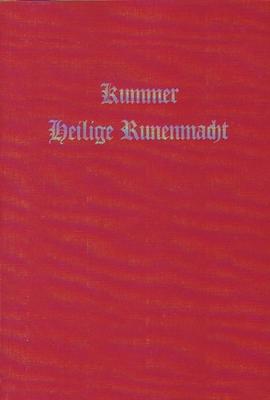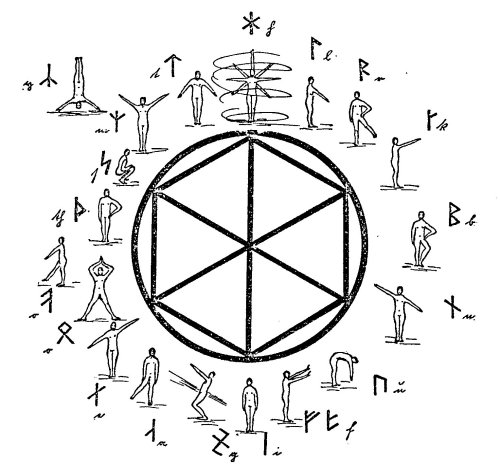Siegfried Adolf Kummer
1899 - ?
Siegfried Adolf Kummer was born in 1899 and was one of the pioneers of operative Runic studies in the early part of
the 20th century. Little is known of his life or of his fate in the wake of the historical events of the Nazi era. He, along
with Friedrich Bernhard Marby, was criticized by name in a report made to Heinrich Himmler by his chief esoteric
runologist Karl Maria Wiligut. But what his fate was is unknown. At least one report has him fleeing Nazi Germany in
exile to South America.
Kummer lived in and around Dresden in the years before the assumption of power by the National Socialists in
1933. He founded his Rune-School Runa in 1927. This presumably rema ined in operation until the National Socialist
regime closed down all such organized activity soon after coming to power in 1933.
ined in operation until the National Socialist
regime closed down all such organized activity soon after coming to power in 1933.
His book, 'Runen-Magie' (available here or here as afree PDF) and here to buy) was first published in 1933 as a part of the Germanische Scfiriftenfolge [Teutonic Writings Series].
It is to some extent a practical condensation of his larger work, Heilige Runenmacht (available here) published in 1932.
To understand Kummer's work completely, you will have to understand the magical world of Guido von List
(1848-1919), the grandfather of the Germanic magical revival. The best introduction to List's ideas can be found in The
Secret of the Runes, translated and introduced by Stephen E. Flowers in 1988. Also my Rune Might (Llewellyn, 1989)
contains a historical and practical introduction to that world of Armanic rune magic generally pioneered by List.
Kummer's work largely belongs to that school of occult thinking prevalent in Germany during the first few
decades of the 20th century which is sometimes called "Ariosophy" today. (This is a term coined by Lan z von
Liebenfels based on analogy with the other "-sophies" of the day: Theosophy and Anthroposophy.) But more
specifically Kummer identified himself as an Armanist, the school founded by Guido von List. Three of the most
important general tenets of Armanism are:
z von
Liebenfels based on analogy with the other "-sophies" of the day: Theosophy and Anthroposophy.) But more
specifically Kummer identified himself as an Armanist, the school founded by Guido von List. Three of the most
important general tenets of Armanism are:
1) All dualities, such as those between the body and the soul, or between humanity and nature, are both real at one
level and only apparent at another. There is a singular essence, but it finds itself in differing conditions, which cause it
to appear in various forms. But the conditions are in turn also real. This is the key to why techniques for the
modification of physical conditions (eugenics, gymnastics, etc.) are seen in spiritual terms by Armanists.
2) All things in the cosmos are subject to a threefold cyclical process of Arising-Being-Passing away to new
Arising: Birth-Life-Death/Rebirth. This is the key to the evolution of the individual and of the ethnic u nit.
nit.
3) Ancient Armanic cultural features were not wiped out by the coming of Christianity—but found refuge in the symbolism used by the church itself and in folk customs. Today these await decoding that they may once again live in their rightful place.
These tenets are further explained in S. E. Flowers' introduction to Guido von List's The Secret of the Runes.
Examples of all of them can be found in the pages of Kummer's Rune-Magic.
The idea of "Ariosophy" as such also involves the Theosophical notion of there being an evolutionary process at
the leading edge of which the "Aryan" stands. Ariosophy also includes the specific idea that there was a time period in
which "god-men" and "beast-men" existed as separate species, but that at a certain time in the distant past they began
to interbreed—resulting in the present form of homo sapiens. Ariosophy preaches the necessity of "breeding out" the"beast-man" characteristics to return to the former divine state of the "god-man."
There are several statements made, or sentiments expressed, by S. A. Kummer in the text of Rune-Magic which
might be found to be "offensive" by the politically correct, and some that are factually erroneous. Rather than
censoring Kummer, or arbitrarily editing him, we have translated his work as it stood in 1933. This is in keeping with
the general editorial philosophy of the publisher not to "sanitize" controversial works. It is felt that the documents will
have more historical, as well as intellectual, value if they are allowed to speak for themselv es.
es.
Notes have been added
to the text where warranted.
When translating any of the Ariosophical literature there are always problems regarding word-plays the original
writers use, which may be impossible to represent in English terms. Where possible cognate translations are used
which preserve the sound correspondences or word-play. But sometimes other solutions' must be found. Words
appearing in square brackets [ ] are information not belonging to the translation proper but which has been included by
the editor. This is often an original German word, the form of which may be helpful to the understanding of the
magical or poetic logic of the text. Or bracketed words may be etymological translations of certain "magical words" or
names in the original German text. These measures have been found to be necessary in the translation simply because
so much of the linguistic magic of the Armanen is dependent on similar sounding words or folk-etymological wordplays.
Thorsson - Texas, February, 1993
From his ntroduction of the English translation of "Rune Magic" by S.A. Kummer, available to buy or as a free PDF file above.